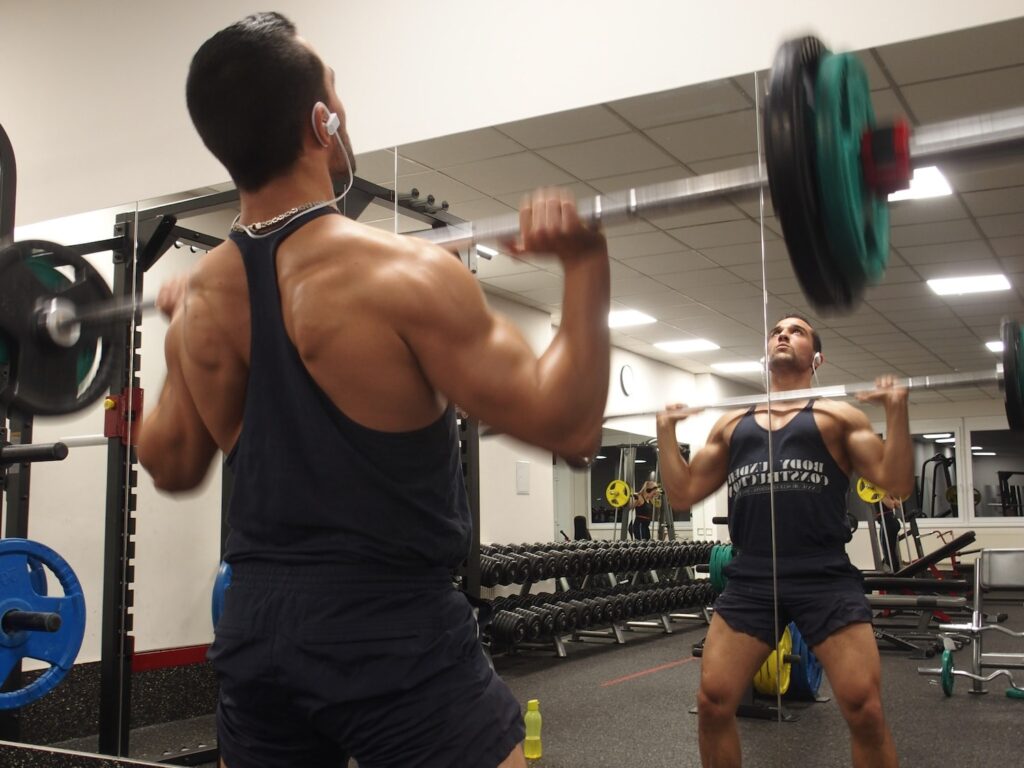Hang Clean Vs. Power Clean: Which Is Better for Athletes?

Both the hang clean and power clean are Olympic weightlifting exercises that involve lifting a barbell from the floor to the front rack position. While they are similar exercises, they differ in their starting position and technique. Both are great for building strength, power, and explosiveness in the lower body, back, and shoulders. In addition, athletes and weightlifters often use them as part of their strength and conditioning programs. But is the hang clean vs. the power clean more valuable to high school and college athletes trying to develop explosive strength? First, let’s discuss the difference between a hang clean and a power clean from the floor.
The Power Clean
The power clean starts with the barbell on the ground. The lifter uses their legs, hips, and back to pull the barbell up explosively, catching it at shoulder level or higher. This lift involves a triple extension of the ankles, knees, and hips to generate power and momentum to lift the bar. The power clean allows you to lift more due to the increased power generated from the full extension at the start of the lift. This exercise also involves a greater range of motion than the hang clean, as the bar must be lifted from the ground.
The Hang Clean
The hang clean starts with the lifter holding the barbell at the mid-thigh level. From there, they will explosively pull the barbell up to shoulder height. Then, they will drop their body underneath the bar and catch it in a front squat position. The hang clean involves a shorter range of motion vs. the power clean, as the bar is already elevated. And, it requires less mobility and flexibility since it starts from a higher position.
While both exercises work for the same muscle groups, the hang clean emphasizes the upper body and traps. In this exercise, the lifter must initiate the movement from a static position. The power clean requires more leg drive and explosiveness to lift the bar from the ground.
The Problem With Hang Cleans
The biggest issue that strength coaches run into with the hang clean vs. power clean is that the more athletes attempt to hang clean, the more they begin to “cheat” the lift. Instead of maintaining proper form, they perform what is known as a “hip clean.”
Hip cleaning is a common variation performed in Olympic lifting where the athlete “pockets” the bar in the hip. This means that all the weight is distributed to sitting in the hip crease. Then, the athlete violently thrusts the hips forward to propel the bar’s weight up. If overused, this can cause changes to the full clean performed from the ground.
During this exercise, the arms become massively bent, and the force exerted to lift the bar over utilizes the hips. This takes out the kinetic chain of the movement and will train the body to have extremely bent arms before reaching extension. As a result, the bar decreases velocity, and the lift becomes less efficient. The hip clean should not be used for training as it will reinforce bad technique.
The Solution
To combat this, coaches must focus on teaching proper mechanics emphasizing the explosive drive from the legs and hips. This training should include starting the pull from the floor with a strong back extension to move the bar quickly off the ground. The athlete should then use as little arm and shoulder drive as possible while maintaining a proper set position and finish.
Coaches can also use light bands or chains to increase the speed of the bar during the lifting phase. These devices can help to build explosive power while reinforcing proper technique. Additionally, coaches should implement pauses in various parts of the lift. They allow athletes to feel and identify where their energy is coming from.
Hang Clean vs. Power Clean: Which Is Right for Your Athletes?
In short, the power clean from the floor is superior for athletic development in high school and college athletes for two main reasons.
First, the power clean involves more muscle activation throughout the body and is more effective for developing overall strength and power. Since the power clean is performed from the floor, the legs are utilized more, allowing power to be driven through the floor and into the barbell for a longer period. The velocity is also steadily increasing throughout the pull off the floor.
In the hang clean, the legs are utilized in two separate motions: deadlifting the weight off the floor and moving the bar from the hips to the shoulders. As a result, the hang clean produces much less power. And, it does not allow full-force production to build over time, which would produce more power for the athlete.
The second reason the power clean is preferred is that, in the hang clean, many athletes begin to “hip clean” in an extreme manner. This variation causes the athlete to “pocket” the bar, thus reinforcing bad technique and not optimizing triple extension.
Get Customized Training From The Moffitt Method
Are you debating the benefits of the hang clean vs. the power clean or developing a complete strength and conditioning training program for your athletes? The Moffitt Method can help you create a regimen to help your athletes develop explosive power.
Our programs are designed to improve the performance of your team as a whole while also dialing in on the needs of each athlete. Start by connecting with a real coach with years of experience through our mobile application. Then, receive customized training, record athletic improvement, and adapt your program as needed.
Get in touch with us via phone or text at 337-279-3561 or message us with questions. Together, we can help your athletes develop the proper technique for top performance.